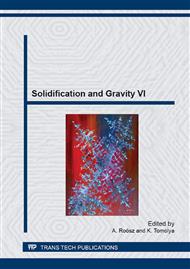[1]
D.M. Lee, J.H. Sun, D.H. Kang, S.Y. Shin, G. Welsch, C.H. Lee, A deep eutectic point in quaternary Zr-Ti-Ni-Cu system and bulk metallic glass formation near eutectic point, Intermetallics, 21 (2012) 67-74.
DOI: 10.1016/j.intermet.2011.09.006
Google Scholar
[2]
Y.F. Sun, H. Fujii, N. Tsuji, Y. Todaka, M. Umemoto, Fabrication of ZrAlNiCu bulk metallic glass composites containing pure copper particles by high-pressure torsion, J. Alloys Compd. 492 (2010) 149–152.
DOI: 10.1016/j.jallcom.2009.11.135
Google Scholar
[3]
H.S. Wang, Y.Z. Su, J. S.C. Jang, H.G. Chen, A comparison of crystallization behaviors of laser spot welded Zr-Cu-Ag-Al and Zr-Cu-Ni-Al bulk metallic glasses, Mat. Chem. Phys. 139 (2013) 215-219.
DOI: 10.1016/j.matchemphys.2013.01.025
Google Scholar
[4]
M. Yan, J. Zou, J. Shen, Cooling rate effects on the microstructure and phase formation in Zr51Cu20. 7Ni12Al16. 3 bulk metallic glass, Sci. Tech. Adv. Mat. 7 (2006) 806–811.
Google Scholar
[5]
L.P. Déo, M.A.B. Mendes, A.M.S. Costa, N.D. Campos Neto, M.F. de Oliveira, Applying a new criterion to predict glass forming alloys in the Zr–Ni–Cu ternary system, Journal of Alloys and Compounds 553 (2013) 212–215.
DOI: 10.1016/j.jallcom.2012.11.123
Google Scholar
[6]
H. Shao, Y. Xu, B. Shi, C. Yu, H. Hahn, H. Gleiter, J. Li, High density of shear bands and enhanced free volume induced in Zr70Cu20Ni10 metallic glass by high-energy ball milling, Journal of Alloys and Compounds 548 (2013) 77–81.
DOI: 10.1016/j.jallcom.2012.08.132
Google Scholar
[7]
J. Dutkiewicz, L. Jaworska, W. Maziarz, T. Czeppe, M. Lejkowska, M. Kubícek, M. Pastrnák, Consoldiation of amorphous ball-milled Zr-Cu-Al and Zr-Ni-Ti-Cu powders, J. Alloys Compd. 434–435 (2007) 333–335.
DOI: 10.1016/j.jallcom.2006.08.201
Google Scholar
[8]
H. Kishimura, H. Matsumoto, Fabrication of Ti-Cu-Ni-Al amorphous alloys by mechanical alloying and mechanical milling, J. Alloys Compd. 509 (2011) 4386–4389.
DOI: 10.1016/j.jallcom.2010.12.181
Google Scholar
[9]
J. Bhatt, B.S. Murty, On the conditions for the synthesis of bulk metallic glasses by mechanical alloying, J. Alloys Compd. 459 (2008) 135-141.
DOI: 10.1016/j.jallcom.2007.04.242
Google Scholar
[10]
D. Oleszak, T. Kulik, Influence of Sn Addition on the Amorphization and Thermal Stability of CuTiZrNi Powders Processed by Mechanical Alloying, Mater. Sci. Forum 636-637 (2010) 917-921.
DOI: 10.4028/www.scientific.net/msf.636-637.917
Google Scholar
[11]
C. Suryanarayana, Mechanical alloying and milling, Prog. Mat. Sci. 46 (2001) 1-184.
Google Scholar
[12]
M.E. Siegrist, M. Siegfried, J.F. Löffler, High-purity amorphous Zr52. 5Cu17. 9Ni14. 6Al10Ti5 powders via mechanical amorphization of crystalline pre-alloys, Mater. Sci. Eng. A 418 (2006) 236–240.
DOI: 10.1016/j.msea.2005.11.024
Google Scholar
[13]
Y.H. Zhao, Thermodynamic model for solid-state amorphization of pure elements by mechanical-milling, J. Non-Cryst. Solids 352 (2006) 5578–5585.
DOI: 10.1016/j.jnoncrysol.2006.09.021
Google Scholar
[14]
M. Seidel, J. Eckert, H.D. Bauer, L. Schultz, Mechanical Alloyed Zr-Based Metallic Glasses with Significant Supercooled Liquid Region, Mat. Sci. Forum 225–227 (1996) 119–124.
DOI: 10.4028/www.scientific.net/msf.225-227.119
Google Scholar
[15]
Z. Bian, G.L. Chen, G. He, X.D. Hui, Microstructure and ductile-brittle transition of as-cast Zr-based bulk glass alloys under compressive testing Mater. Sci. Eng. A 316 (2001) 135–144.
DOI: 10.1016/s0921-5093(01)01260-6
Google Scholar
[16]
K. Tomolya, D. Janovszky, T. Janvari, A. Sycheva, F. Tranta, J. Solyom, T. Ferenczi, A. Roosz, Consolidation of Cu58Zr42 amorphous/nanocrystalline powders by PM, J. Alloys Compd. 536 (2012) S154-S158.
DOI: 10.1016/j.jallcom.2011.12.107
Google Scholar
[17]
G. Körösy, K. Tomolya, D. Janovszky, J. Sólyom, Evaluation of XRD analysis of amorphous alloys, Mater. Sci. Forum 729 (2013) 419-423.
DOI: 10.4028/www.scientific.net/msf.729.419
Google Scholar
[18]
G.S. Firstov, Yu.N. Koval, A.N. Timoshevskii, J. Van Humbeeck, Dopov. Nats. Akad. Nauk. Ukr. (2010) 103-109 (ICSD#: 167595).
Google Scholar
[19]
R. Meyer zu Reckendorf, P.C. Schmidt, A. Weiss, Reaction of Hydrogen with the Heusler-Type Phases Cu2TiAl and Cu2ZrAl, Zeitschrift für Physikalische Chemie 163 (1989) 103-108 (ICSD#: 656062).
DOI: 10.1524/zpch.1989.163.part_1.0103
Google Scholar
[20]
Y, Yokoyama, H. Inoue, K. Fukaura, A. Inoue, Relationship between the liquidus surface and the structure of Zr-Cu-Al bulk amorphous alloys, Mat. Trans. 43 (2002) 575-579.
DOI: 10.2320/matertrans.43.575
Google Scholar


